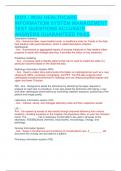D033 - WGU HEALTHCARE
INFORMATIOM SYSTEM MANAGEMENT
TEST QUESTIONS ACCURATE
ANSWERS GUARANTEED PASS.
Descriptive Statistics
- Ans - Numerical data; mean/median/mode. In healthcare looks for Trends in the data;
help leaders make good decisions, which is called descriptive analytics.
Dashboards
- Ans - Summarized or aggregated reports of process measures to help leaders follow
progress to assist with strategic planning. It provides the status on key measures.
Predictive modeling
- Ans - A process used to identify patterns that can be used to predict the odds of a
particular outcome based on the observed data.
Radiology Information System (RIS)
- Ans - Used to collect store and provide information on radiological test such as x-rays
ultrasound, MRIs, computed, tomography, and PET. The RIS also supports other
radiological procedures performed in radiology such as ultrasound guided biopsies and
upper and lower GI series.
RIS - Ans - Designed to assist the technician by identifying the steps required to
prepare for each test or procedure. It can also assist the technician with taking x-rays
and other radiological examinations by controlling radiation exposure, positioning of the
patient and image quality.
Laboratory information system (LIS)
- Ans - Collects, stores, and manages laboratory tests and their respective results
LIS –
Ans - Can speed up access to test results through improved efficiency from various
locations, including anywhere in the hospital, the physicians office, or even the clinicians
home. The ________ has a necessary functionality to be used in all areas of the
laboratory, including blood chemistry, blood banks, microbiology, virology, and
pathology.
Nursing Information System
- Ans - Assist in the planning and monitoring of overall patient care. A _________ will
document the nursing care provided to a patient.
Pharmacy information system (PIS)
, - Ans - Assist providers in ordering, allocating, and administering medication. Help
providers reduce medication errors by using the hospital information system, the ER,
and the ________, combine with information from medical databases and drug
formularies.
What do PIS's check for?
- Ans - Drug interactions, food, and drug interactions, and other contradictions. When
problems are identified, the PIS alerts the pharmacist or end-user. It should also
determine whether or not the dosage and administration method is appropriate for the
size and age of the patient. The PIS can also manage the inventory of drugs in the
pharmacy.
Emergency department system
- Ans - Designed to meet the unique needs of the emergency department, including
tracking patients from triage to discharge. The ________ is also able to record test
results and other clinical information. It can also assist in the apartments, workflow and
generate management report such as turnaround times, patient wait times, and more.
Patient monitoring system
- Ans - Automatically collects in stores patient data from various information systems
used in healthcare. It includes fetal monitoring, vital signs, and oxygen saturation rates.
It is typically utilized in the intensive care units and other specialty areas such as the
operating and recovery rooms.
Health Information Exchange (HIE)
- Ans - The exchange of health information electronically between providers and others
with the same level of interoperability
inferential statistics - Ans - Generalize about a population based on a sample.
Diagnostic analytics
- Ans - Helps a healthcare organization determine why something happened.
Diagnostic analytics tools: dashboards, and data mining.
Predictive analytics
- Ans - Analyzes historical data to make predictions. Example: ___________ analytics
may determine the expected readmission rate. The prediction may or may not come
true as many factors can impact future events.
Prescriptive analytics
- Ans - Builds upon predictive analytics by adjusting possible courses of action the
healthcare organization may take and what the implications may be for each. Example:
looking at causes of admissions and making changes and processes or other factors.
, Predictive modeling - Ans - Identify patterns/predicts the odds of a particular outcome
based on the observed data. ________ models use historical data in order to predict
what is likely to happen in the future.
Clinical pathways
- Ans - A tool designed to coordinate multidisciplinary care planning for specific
diagnosis and treatments
Health informatics
- Ans - A science that defines how health information is technically captured,
transmitted, and utilized. This field of study uses information systems to manipulate and
use information to improve healthcare. It is only possible because the data are stored in
the information systems.
Data analytics
- Ans - The science of examining raw data with the purpose of drawing conclusions
about that information. This information can then be used to make business decisions
concerning which services to provide and how to improve patient care.
Data mining
- Ans - The process of extracting and analyzing large volumes of data from a database
for the purpose of identifying hidden and sometimes subtle relationships or patterns and
using those relationships to predict behaviors. It uses data to determine differences in
the way physicians, practice medicine, determine changes in the patient being seen,
and more.
Health informatics - Ans - is a multidisciplinary field that is concerned with the cognitive,
information-processing, and communication tasks of the healthcare practice,
education, and research, including the information science and technology to
support these tasks?
Data statistics
- Ans - used to make conclusions about a population
Health Informatics
- Ans - The field that uses technology to manipulate and use information to improve
healthcare
financial applications - Ans - first ISs used in healthcare
Data analytics tool
- Ans - dashboard
data integrity tool
- Ans - required field




